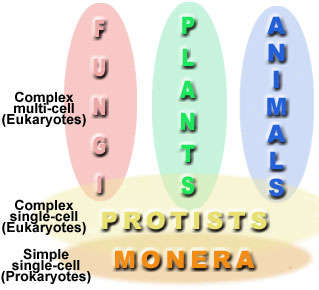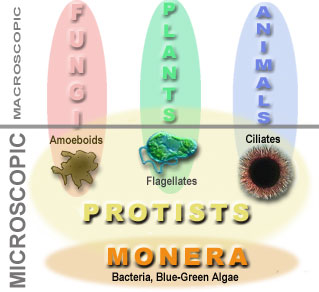
 |
A widely used scheme for describing life, developed by Robert Whittaker in the 1960s, divides all living organisms into five kingdoms: Monera (bacteria), Protists, Fungi, Plants, and Animals. These kindgoms are broadly separated by how its members feed: animals swallow food, plants photosynthesize, fungi absorb food molecule by molecule. etc. This scheme coexists with categorization by cell complexity:
|
|
The upper part of the
diagram at right (>>) features the complex, multi-celled organisms.
You are probably quite familiar with these organisms because they're
visible to the naked eye, or "macroscopic." The grey horizontal
line separates these visible organisms from the "invisible"
(i.e., microscopic) realms of Protists and bacteria (Kingdom Monera).
But please note that there ARE some microscopic forms of Fungi, Plants, and Animals... and macroscopic Protists, as well. Read on... |
 |
 |
Now focus on the lower part of the Whittaker scheme diagram (<<). Although all are single-celled organisms, Protists and Monera are eukaryotes and prokaryotes, respectively. In this scheme, some Protists -- amoeboids, flagellates, ciliates -- are shown to overlap with the Fungi, Plants, and Animals. These "overlaps" are based on similarities with organisms in these Kingdoms. However, recent advances in molecular-biological techniques are changing our views on the nature of diversity of microscopic organisms... and how to classify them, as well.
|
|
Did you know that
many marine organisms are classified by how they move, their size,
and source of energy? Click
here for details.
|
|